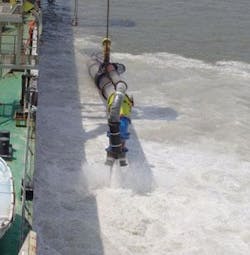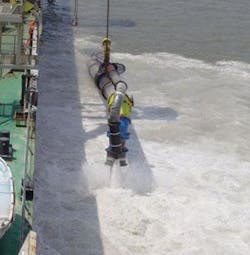Mumbai High trenching stays ahead of monsoon
Boskalis Westminster Middle East has completed a program of pre-trenching/backfilling and post-trenching required for the Mumbai High fields-Uran trunkline. The 204-km, 30-in. oiland 28-in. gas lines run from Mumbai High offshore western India to the reception terminal onshore at Uran. The state-owned Oil and Natural Gas Corp. initiated the project - one of the longest pipeline schemes of recent times in the Asia-Pacific region -with the purpose of replacing existing trunk lines.
Under a contract from main contractor Hyundai, Boskalis completed the pre-trenching, backfilling, and landfall works in late April. Under a variation order, the project team went on to finish post-trenching of the offshore trunk lines by end-May, prior to arrival of the Monsoon season.
Dredging for the main works began last November and had to be completed by the end of the six-month dry season. The trailers Seaway and the shallow water-capable Flevo (13,255 cu m and 2,130 cu m respectively), together with the backhoe Colbart handled this work. The latter was rigged with an S35 Hydrohammer to tackle hard material.
Pre-trenching ran from the landfall to a position 19.5-km offshore (the port limit). The contract specified 3 m cover in soft material and 1 m cover in hard material. The near-shore section of trench was dredged to a width of 8 m, widening to 10 m further offshore. Boskalis’ scope extended to dry excavation of the onshore/tidal section of the trench; dredging of a 60-m wide lay-barge access channel; and trench maintenance and backfilling of the trench and lay-barge access zone. Soils encountered varied from very soft clays to weathered basalt (in layers up to 1 m thick). The Seaway removed 1.5 MMcm of material, while the Flevo dredged around 300,000 cu m from the shallows.
The variation order called for post-trenching and burial (to 1 m) of the new trunk lines over a distance of 180 km. Boskalis deployed two trailers, the Seaway and WD Fairway, for this task. Seaway was already on site, while WD Fairway had to be mobilized from Dubai. Both were rigged for jetting.
Boskalis Offshore Area Manager Jan Dompeling says, “The trailing suction hopper dredgers were quite easily transformed into jetting tools by reversing the flow in the dredger and by replacing the draghead with a nozzle. The equipment performed well and by this post-trenching method we succeeded in lowering the pipeline to a depth of 2 m.”•

